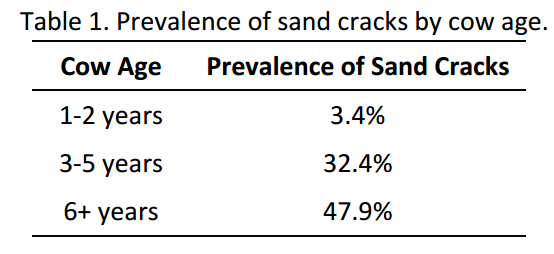Hoof Cracks in Beef Cattle
Hoof cracks can be common in older cattle as they increase in weight.
By: Rachel Endecott, Montana State University Extension, Beef Cattle Specialist
In general, foot cracks are classified as either horizontal (transverse fissures) or vertical (sand cracks).
The mildest form of a horizontal foot crack is known as a hardship groove, which is thought to be associated with disease, stress, or nutritional abnormality. A Canadian study of 6 different beef cattle herds found that the prevalence of hardship grooves varied from 29-100%. In these herds, the grooves were associated with a change from winter feed to lush spring grass or in response to weather conditions resulting in a flush of grass. The researchers termed this “pasture shock” and suggested that a laminitis-like mechanism may have been activated. Their recommendations to minimize pasture shock included avoiding turnout into very lush grass as the first pasture in the spring, to leave some residue on a pasture in fall and graze it first at spring turnout, and to avoid legume pasture as the first to be grazed in the spring. (Aside: These recommendations may also help prevent grass tetany!)
Hardship groove depth may vary from a very shallow depression (1 mm deep) to penetration of the entire wall. The latter case is termed a fissure. When a fissure reaches the midpoint of the hoof wall, it acts as a hinge and the wall may bend. As a fissure approaches the lower third of the toe, it tends to partially break away and is then referred to as a thimble, which is an extremely painful condition.
Vertical foot cracks are often referred to as sand cracks. Studies conducted in northwestern Alberta grazing districts showed a prevalence of sand cracks from 20-25%. A higher incidence of cracks were found on the outside toe compared to the inside toe (81% vs 19%, respectively). The outside toe bears a significantly larger are of ground contact than the inside toe. In one study, of cows with hoof cracks, 62% had one crack, while 91% had one or two hoof cracks. A subsequent Alberta study found that grazing cows that had cracked hooves were older, heavier (weight), and fatter (condition score) than cows without cracked hooves. However, the number and severity of cracks was independent of cow age, weight, or condition.
The prevalence of sand cracks increased as cows aged from 1-2 years to 3-5 years. A numerical increase in sand cracks was observed in cows 6 years of age or older, but was statistically similar to the middle age group (Table 1).
The researchers grouped cows into two weight categories: less than 1150 pounds and greater than 1150 pounds. Cows in the lighter group had an 8.4% prevalence of sand cracks while 32.3% of the cows in the heavier group had sand cracks. When the interaction of cow weight an age was examined, it appears that cows with a heaver weight at a younger age had a higher probability of having sand cracks (Table 2).
So what causes sand cracks? These Canadian studies suggest that shear force of weight influences prevalence. However, we don't yet have a thorough understanding of the environmental, nutritional, and genetic factors that interact to result in sand cracks. Some researchers speculate that variation in the size and shape of the claw (toe) plays a role in the strength of the claw, and that animals with less claw volume at a similar weight and age may not be able to withstand as much stress on the claw.
Trace minerals and vitamins play an important role in hoof health. Proper supplementation with copper and zinc if needed can help ensure hoof integrity. If there are antagonists to copper and zinc present in the environment (sulfates, molybdenum, iron), they may have a negative impact on the availability of these minerals. Vitamins A, E, and the B vitamin biotin are all important for hoof health. Vitamins A and E play a role in tissue growth and repair and immune function. Biotin is associated with formation of the hoof horn and is important to claw hardness.
Finally, we know that genetics can play a role in hoof quality. Different sire lines and cow families are known to have a higher prevalence of cracked feet than others.









